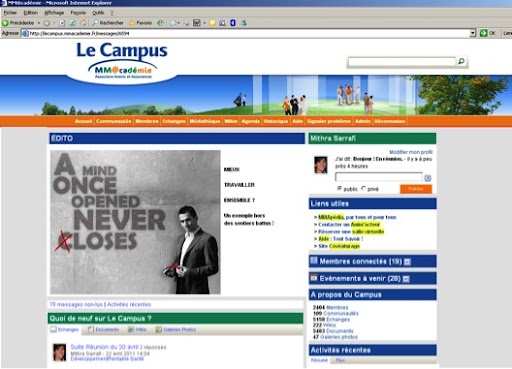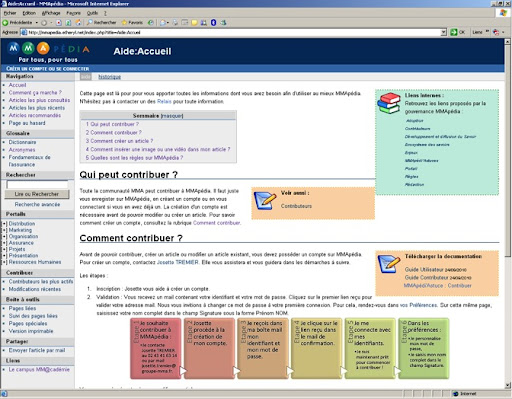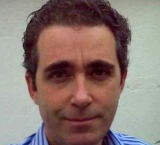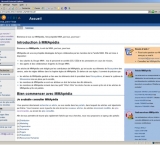Story:
Coaching Goliath - How we are building collaboration into the organizational fabric of MMA
In 2007, the company was finishing integration of two major acquisitions and had launched several initiatives intended at reunifying the existing cultures into one single culture. It had decided to transform its emerging university into an R&D focused academy, MM@cademie, that would identify and explore key societal, technological and managerial trends impacting MMA's business in the near future.
- MMA CEO decided to lead the Governance body of our Collaborative Way initiative (Strategic Committee);
- We designed a structure in which to experiment new management ways (Professional Communities)
- MMA bought and implemented from the outset a community platform from an existing vendor.
- At the people level, we fought to convince and recruit volunteers as facilitators for our communities;
- At the IT level, we tried to stress how new social technologies would actually change relationships, and therefore profesionnal behaviours and management (and, eventually, organization). One of our initiatives was successful enough to attract interest from IT department and serve as a pilot initiative to test MS Sharepoint.



- First, they are trying to avoid politic and functional barriers by working in the community;
- Secondly, they are forcing top management to collaborate differently by mobilizing them not only for decision making, but also for collaborative problem solving.
Getting ready for full deployment
Our project is now getting ready for wider deployment, that should be based on three pillars:
- How improved collaboration impacts existing processes and businesses;
- How new structures (communities) provide a vehicle to implement programs, projets, activities that were not possible yesterday;
- How the collective intelligence of the group can be tapped beyond conversations.
In getting ready to succeed, MM@cademie is transfering knowledge & skills to operations and functions, and is also transfering leadership of these initiatives to them. This transfer is best understood as organizational coaching, as, in accepting this role, functions (such as HR or IT) are almost forced to change themselves in their management ways.
- From an individual point of view (behaviours and management ways), we have adopted from the outset the collaboration attitude and behaviours that we plan to see deployed in the company, and we have made the volunteers adopt these ways, even when it seems difficult. We have first adopted very open, almost web2.0 like attitudes, and have afterwards worked with community members in making them much more professional (accountability, governance);
- From an organization point of view, we have insisted in structuring very carefully our professional communities. Instead of working on what the company will look like in some years, when collaboration is deployed, we have worked on making sure that collaboration happens at the community level, and we expect from this new community work the innovations that will transform MMA.
- Adoption of structural changes to the organisation (HR practices, including dévelopment, evaluation, recognition and compensation);
- Increase speed of decision making
- Tackle French regulatory context and issues
- Deploy collaboration externally, to live up to the company new baseline, "your new insurance social network".
- Focus at the same time on organization and people evolution, working with a co-design mindset. Even though the basecamp team is at the forefront of management thinking, every innovation that we spotted was developed and formalized by a group of volunteers within a professional community. What is interesting is that a professional community is different from existing structures and that volunteer based work is different from classic command & control;
- Adopt a "beta mindset" for technology adoption. We launched a community platform at the beginning of our work, and have worked with our vendor to improve it ever since. Everytime a new initiative needed a new kind of technology, we had executive support to test it. It was the case for MMApedia and MMABook;
- Always adopt a positive atittude in regard to people that resist change. Fact is, they are just doing their job and keeping with their responsibilities ! So the best is to work on opening management eyes, (we had a group of volunteers visit several companies in Sillicon Valley, have had several top-to-top meetings with French leading vendor Dassault Systèmes, and conducted external interviews).
- Turn leadership upside down. We had a huge impact from the leadership team as MM@cademie was challenged to spot key changes needed, experiment, test feasibility and support (within the organization) and then present to the Strategic Committee. This last played its role as a partner, but has never set directions nor proposed changes. It has ensured that whatever was experimented was adoptable without a major disruption.
- First, Pascale Leclerc, for her intuition, vision, resilience and capacity to maintain course no matter what conditions prevail;
- Secondly, all Campus members, with a particular note for the Anim'acteur group, who have experimented new ways of working, sometimes in difficult conditions, and have participated in designing the key innovations that are described here;
- We are indebted to Dominique Turcq, whose thought leadership got us going in the first place;
- The whole story was possible because it got continued executive sponsorship, which means that credit goes first to MMA CEO, Christian Baudon.





You need to register in order to submit a comment.